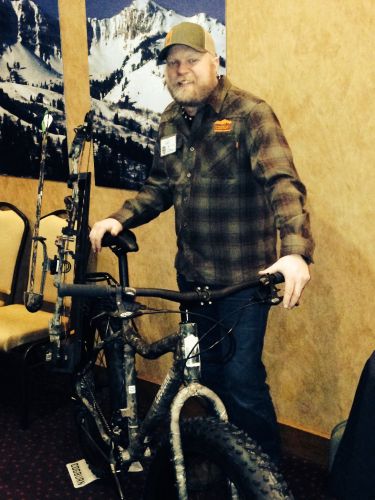OGDEN, Utah (BRAIN) — Mike Van Abel, IMBA's executive director, told more than 110 participants at the annual Fat Bike Summit that it's time to develop rules to guide the use of fat bikes on public land and private property.
"This is a real live sector; this isn't just a fad. And it's going to grow," Van Abel said. Now is the time to get ahead of the curve, he pointed out. Mountain biking developed so fast—and with no rules—that it sparked an array of land use issues, hiker-biker and biker-equestrian conflicts that still resonate with the public.
"Fat bikes have the potential of creating a sizable user group, too, and we need to talk about how to head off those potential user conflicts," he said. While fat bikes can be ridden in any weather, potential trail use issues between snowmobilers, snowshoe users and Nordic skiers were front and center at this third annual summit for fat bike enthusiasts.
The audience included staff from the Bureau of Land Management, U.S. Forest Service, National Park Service, state and local land managers, access advocates, industry representatives from SRAM, Shimano, TRP, Mountain Bike Action and others, plus 37 bicycle retailers as well as operators of Nordic ski areas.
QBP, which has a distribution center in Ogden, has organized the event three years in a row. This year's Summit examined the state of the fat-bike industry, access issues and new snow grooming techniques that could open up sales to thousands of new participants, particularly in snow country.
While über fat tires can roll over most terrain, once winter weather lays down four inches or more of new snow even strong cyclists can struggle. Nordic ski areas offer fat-bike riders groomed terrain—and a potential new revenue source for operators—while fresh snowmobile and snowshoe tracks make it easy for fat bikes to navigate winter backcountry. Plus there is a burgeoning array of fat-bike races and festivals.
The Nordic ski industry, however, should pay attention. Fat bikes have the potential to further hollow out an activity that's already in general decline in the U.S., Van Abel said in an interview. To develop the skills needed to be a confident cross-country skier takes time and lessons. Fat bikes, on the other hand, are easy to ride and on a groomed trail will travel at the speed of a competent skier.
"We're not advocating for unilateral access for fat bikes versus Nordic skiers, but this is a new revenue source for them," he said. Fat-tire bikes can roll over sandy beaches, dessert sand, frozen lakes, ice encrusted shorelines or rocky scree as easily as navigating single track. They are user friendly.
Last year, QBP introduced its Cogburn line of fat bikes for the hook-and-bullet crowd who want to get into distant areas quickly, quietly and without causing damage to the environment.
Bobby Dahlberg, QBP's sales and marketing manager for Cogburn, pointed out that fat bike sales overall are just north of $10 million. "It's a small amount, but it's a quick growing segment," said Dahlburg, who had a Cogburn at the Summit equipped with an accessory holding a bow and a quiver of arrows.
A graph of fat-bike sales since 2005 through 2013 looks like a "hockey stick." Fairly flat and then in 2010 sales shoot straight up. According to QBP's data more than 20,000 units have been sold to date—most of them by QBP—which put its financial muscle behind developing the bikes and later rims, tires and accessories. Trek and Specialized have taken notice and introduced a line of fatties for 2014.
As for retailers, fat bikes could be a new profit center. Gary Sjoquist, QBP's advocacy director, did a quick survey of fat-bike owners in the audience. Almost all of them had spent upwards of $3,000 and more for their bikes and accessories. "People don't understand the level of commitment people put into these bikes," Sjoquist said.
Bicycle Retailer & Industry News will examine the fat bike phenomenon in the March 1 issue.




